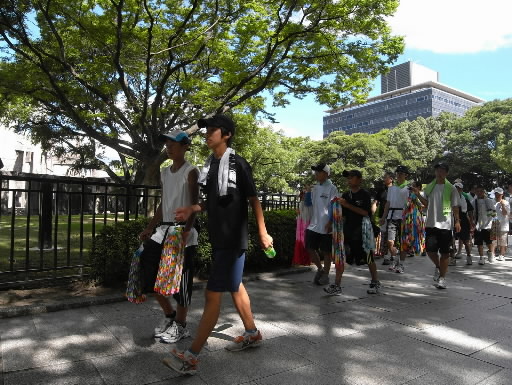“Walk to Hiroshima” honors 70 kilometer-flight of A-bomb survivors
Sep. 10, 2012
The path that atomic bomb survivors followed in fleeing the atomic bombing of Hiroshima to the town of Oonancho in Shimane Prefecture is retraced, in reverse, every summer. An event called “Walk to Hiroshima” is organized by a group based at the Oonancho Community Center and involves participants walking from the town to the A-bomb Dome in the heart of Hiroshima. The event is held each year, a couple of days before the August 6 anniversary of the atomic bombing. This year marked the 25th “Walk to Hiroshima” with 70 participants making the trek on August 4 and 5.
The first “Walk to Hiroshima” took place in 1988. The idea was inspired when one member of a local mountaineering group recalled how a parent and child who had experienced the atomic bombing of Hiroshima took refuge at that person’s house. To convey the experience of their flight from Hiroshima, the walking event was begun.
The distance is approximately 70 kilometers. As the blazing sun of August beats down, the participants forge on, sleeping only about two hours at night. Despite the grueling nature of the walk, it has been held year after year, and the total number of participants is now estimated at almost 1,000. About 60% have been junior high school and high school students.
One of the organizers of the event, local resident Yozo Tanaka, 55, said, “I want to change the attitude of junior high and high school students toward the atomic bombing from indifference to interest. I don’t tell the participants what we want them to think, but I believe they still come to the same understanding.” Before the participants actually pursue the walk, they take part in a study session and watch a DVD about the atomic bombing.
Manato Komagawa, 14, a third-year student at Iwami Junior High School, joined the walk for the first time. After reaching the A-bomb Dome, he said, “It’s amazing that the A-bomb survivors walked such a long way. I’m now able to understand their hardships a little more, like their sore legs and feet and their injuries and weak condition.” (Junichi Akiyama, 16)
(Originally published on August 20, 2012)
The first “Walk to Hiroshima” took place in 1988. The idea was inspired when one member of a local mountaineering group recalled how a parent and child who had experienced the atomic bombing of Hiroshima took refuge at that person’s house. To convey the experience of their flight from Hiroshima, the walking event was begun.
The distance is approximately 70 kilometers. As the blazing sun of August beats down, the participants forge on, sleeping only about two hours at night. Despite the grueling nature of the walk, it has been held year after year, and the total number of participants is now estimated at almost 1,000. About 60% have been junior high school and high school students.
One of the organizers of the event, local resident Yozo Tanaka, 55, said, “I want to change the attitude of junior high and high school students toward the atomic bombing from indifference to interest. I don’t tell the participants what we want them to think, but I believe they still come to the same understanding.” Before the participants actually pursue the walk, they take part in a study session and watch a DVD about the atomic bombing.
Manato Komagawa, 14, a third-year student at Iwami Junior High School, joined the walk for the first time. After reaching the A-bomb Dome, he said, “It’s amazing that the A-bomb survivors walked such a long way. I’m now able to understand their hardships a little more, like their sore legs and feet and their injuries and weak condition.” (Junichi Akiyama, 16)
(Originally published on August 20, 2012)








